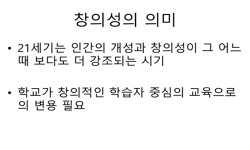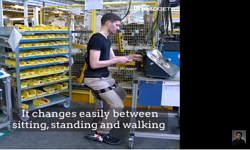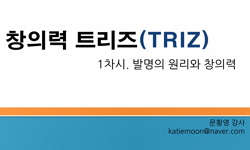Creativity is the primary topic in 21st century. The Education, Science & Technical Department has announced that the major subject would be focusing on ‘Creativity’ and provided its fundamental directions on creativity and personality in 2009. Cr...
http://chineseinput.net/에서 pinyin(병음)방식으로 중국어를 변환할 수 있습니다.
변환된 중국어를 복사하여 사용하시면 됩니다.
- 中文 을 입력하시려면 zhongwen을 입력하시고 space를누르시면됩니다.
- 北京 을 입력하시려면 beijing을 입력하시고 space를 누르시면 됩니다.
https://www.riss.kr/link?id=T13566231
- 저자
-
발행사항
서울: 경기대학교 문화예술대학원, 2014
-
학위논문사항
학위논문(석사) -- 경기대학교 문화예술대학원 , 독서지도학과 , 2014. 8
-
발행연도
2014
-
작성언어
한국어
- 주제어
-
발행국(도시)
서울
-
형태사항
ix, 165 p.: 삽도; 26 cm.
-
일반주기명
경기대학교 논문은 저작권에 의해 보호받습니다.
지도교수:서형범
참고문헌 : p.87-91 - 소장기관
-
0
상세조회 -
0
다운로드
부가정보
다국어 초록 (Multilingual Abstract)
Creativity is the primary topic in 21st century. The Education, Science & Technical Department has announced that the major subject would be focusing on ‘Creativity’ and provided its fundamental directions on creativity and personality in 2009. Creativity can be developed through creative thinking and its ability to generate fresh, independent, and useful ideas. Creativity is not inherent naturally, but can be developed by education and training.
Genrich Altchuller, a Russian scholar, developed TRIZ theory. After analyzing over 2 million patent cases existed in the pre-Russian period, he developed the TRIZ theory by systematically analyzing the common theory used for creative problem solving. Although most of big companies including Samsung, LG, and POSCO have adopted the TRIZ theory as a problem solving method, writing related TRIZ method cannot be found easily.
The purpose of this study is mainly for elementary school grade 5 and 6 students to reinforce their creative writing skills by utilizing the TRIZ method. 4 different processes exist in the creative problem solving method for the TRIZ theory. For the creative problem solving method, it requires changing the thinking ability to discover the problem, to define the unbalanced issues, and to eliminate the issues given in the text. By conducting an experiment, creative ability can be measured through before and after TTCT creativity language inspections. It was performed through 10 students who expressed interest in participating in the study program attending M elementary grade 5 and 6 located in Su-Won, Kyunggi-Do. For the inspection tool, the TTCT language inspection program developed by Torrance was used twice before (B type) and after (A type). Based on the results of the inspection sheets, the progress of the participated students’ creativity development was reviewed.
The TRIZ program uses and teaches using a direct study method considering individual students’ differences. The TRIZ program was conducted 8 times and cards specifying 40 different theories for understanding were used. For the purpose of using the TRIZ theory, information on conflict and unbalanced situation written in textbook was used. The information contains conflicted inner and outer text structures. After conducting the study program, the results of the TTCT language inspection sheet from the all students were analyzed as a method for measuring their creativity progress. After that, it was conducted for both overall and personal analyses by comparing the students’ attitude before and after reading.
To find whether the problem solving writing method activity using the TRIZ theory can influence to creativity improvement, a study was performed and the results are summarized below:
First, the TRIZ program offered creative improvement for elementary school students’ grade 5 and 6 positively and influenced those changes to their creativity, flexibility, and independent creativity in lower part of creativity.
Secondly, there were only slight differences in improving creativity among the students who participated in the TRIZ program.
Based on the results above, it is concluded that the TRIZ program can influence elementary school students’ grade 5 and 6 in developing their creativity positively.
Especially, it can be emphasized that the most areas of lower side of creativity such as fluency, flexibility, and independency type of characteristics were all improved.
It is expected that their creativity can be improved if elementary school students can adopt and learn the TRIZ method consistently in their education field.
<Key Words> TRIZ, TTCT Language Inspection, Creativity, Problem Solution, Creative Writing, Contradiction
국문 초록 (Abstract)
21세기 최고의 화두로 떠오르는 것은 ‘창의성’이다. 교육 과학 기술부는 교육의 최대 핵심 과제를 창의성 함양으로 잡고, 2009년 창의, 인성교육 기본 방향을 발표한 바 있다. 창의성이란 창...
21세기 최고의 화두로 떠오르는 것은 ‘창의성’이다. 교육 과학 기술부는 교육의 최대 핵심 과제를 창의성 함양으로 잡고, 2009년 창의, 인성교육 기본 방향을 발표한 바 있다. 창의성이란 창의적인 사고를 통하여 새롭고, 독창적이며, 유용한 것을 만들어 낼 수 있는 능력이다. 창의성은 선천적인 능력이 아니라 교육과 훈련을 통해 개발 될 수 있는 능력이라는 것은 여러 실증 연구들을 통해 알 수 있다.
트리즈(TRIZ)는 러시아의 학자 겐리히 알츠슐러(Genrich Altchuller)가 개발한 ‘창의적인 문제 해결을 위한 이론’이다. 구소련의 200만건이 넘는 특허를 분석하여 창의적 문제해결에 사용되는 공통원리를 추출, 분석해 체계화 한 것이다. 주로 삼성, LG, 포스코 등의 기업들이 트리즈를 활용한 창의적 연구 개발 문제 해결 방법을 사용하고 있지만, 글쓰기와 접목된 트리즈 활용에 대한 연구는 찾아보기 쉽지 않다.
본 연구의 목적은 초등학교 5, 6학년을 대상으로 트리즈 원리를 이해하고 창의적인 문제 해결 글쓰기이다. 트리즈 원리를 위한 창의적인 문제 해결 글쓰기 하는 것을 ‘트리즈 프로그램’이라 명명한다. 트리즈 프로그램은 4가지 단계가 있다. 첫 번째, 텍스트에서 문제를 발견한다. 둘째, 문제의 모순을 정의한다. 셋째, 모순을 제거할 수 있는 사고로 전환한다. 넷째, 문제를 해결 할 수 있는 방법을 찾는 것이다. 트리즈 프로그램에 참여한 학생들은 사전 사후 TTCT 창의성 언어 검사를 통해 창의성이 얼마나 향상되었는지 살펴볼 것이다.
이 연구는 경기도 수원 소재 M 초등학교 5, 6학년으로 본 조사에 참여하고자 의사를 밝힌 11명의 학생들을 중심으로 실시되었다. 검사 도구는 토랜스가 개발한 TTCT 언어 검사를 사전(B형), 사후(A형)으로 동일 검사를 실시하였다. 검사지의 조사 결과를 토대로 대상 학생들의 창의성의 향상의 정도를 살펴보았다.
트리즈 프로그램은 학생들의 개인차를 고려하여 직접교수법을 사용하여 지도하였다. 트리즈 프로그램은 8차시에 걸쳐 시행하였다. 트리즈의 이해를 돕기 위하여 트리즈의 40가지 원리가 적혀 있는 카드를 활용하였다. 모순이 있는 모든 텍스트든 트리즈로 사용이 가능하지만, 트리즈 원리를 적용해야 하는 어려움이 있어 저학년 동화책에서 발췌하여 사용하였다. 트리즈 프로그램을 시행한 후 학생들의 변화를 평가하는 방법으로 TTCT 언어 검사 결과지를 분석하여 전체 피험자의 창의성 변화를 확인하였다. 그런 다음 학생들의 창의성 변화에 따른 전체적인 분석과 개인적인 분석을 하였다.
트리즈 원리를 이용한 창의적인 문제 해결 글쓰기 방법 연구 활동이 창의성 향상에 미치는 영향을 알아보기 위한 연구 결과는 다음과 같다.
첫째, 트리즈 프로그램은 초등학교 5, 6학년 학생들의 창의성 향상에 긍정적 영향을 주며, 창의성의 하위 요인인 유창성, 융통성, 독창성 변화에 효과가 있었다.
둘째, 트리즈 프로그램을 실시한 피험자들 가운에 학생들의 창의성 향상 정보는 학생에 따라 유의미한 차이가 있었다.
이상의 연구 결과를 살펴보면, 트리즈 프로그램 활동이 초등학교 5, 6학년 학생의 창의성 향상에 긍정적인 영향을 미친다는 것을 알 수 있다. 특히 창의성의 하위 영역인 유창성, 융통성, 독창성의 모든 영역이 향상 되었다는 것을 알 수 있었다. 만약 교육현장에서 초등학교 학생들에게 트리즈 프로그램을 지속적으로 지도한다면 꾸준히 창의성이 향상 되리라고 기대 할 수 있을 것이다.
목차 (Table of Contents)
- 1. 머리말 1
- 1.1. 연구 목적 1
- 1.2. 선행 연구 2
- 1.3. 연구 방법 4
- 1.4. 연구 가설 6
- 1. 머리말 1
- 1.1. 연구 목적 1
- 1.2. 선행 연구 2
- 1.3. 연구 방법 4
- 1.4. 연구 가설 6
- 1.5. 연구 제한점 7
- 2. 트리즈와 창의성 8
- 2.1. 트리즈 8
- 2.1.1. 갈등과 모순 8
- 2.1.2. 트리즈의 개념 11
- 2.1.3. 트리즈의 40가지 발명원리 13
- 2.2. 창의성의 개념과 구성요소 25
- 2.2.1. 창의성의 개념 25
- 2.2.2. 창의성 구성요소 26
- 2.2.3. 창의적 문제 해결력 28
- 2.2.4. 창의적 문제 해결력 신장을 위한 트리즈 프로그램 학습법 32
- 2.3. 트리즈와 창의성의 관계 33
- 2.4. 트리즈 프로그램과 글쓰기 지도 36
- 2.4.1. 트리즈 프로그램 36
- 2.4.2. 글쓰기 지도 38
- 3. 조사 방법과 분석 43
- 3.1. 조사 방법 43
- 3.1.1. 측정도구 43
- 3.1.2. TTCT 검사 구성 45
- 3.1.3. TTCT 검사 결과의 해석 47
- 3.2. 조사 대상과 기간 50
- 3.3. 조사 설계 및 절차 52
- 3.4. 트리즈 프로그램의 구성과 적용 53
- 3.4.1. 자료의 구성 53
- 3.4.2. 차시별 수업 내용 61
- 3.4.3. 트리즈 프로그램 적용 62
- 3.5. 조사 결과 분석 69
- 3.5.1. 김ㅇ영의 창의성 사전‧사후 검사 75
- 3.5.2. 김ㅇ솜의 창의성 사전‧사후 검사 76
- 3.5.3. 황ㅇ건의 창의성 사전‧사후 검사 77
- 3.5.4. 서ㅇ경의 창의성 사전‧사후 검사 79
- 3.5.5. 주ㅇ정의 창의성 사전‧사후 검사 80
- 3.5.6. 이ㅇ훈의 창의성 사전‧사후 검사 81
- 3.5.7. 곽ㅇ구의 창의성 사전‧사후 검사 82
- 3.5.8. 김ㅇ희의 창의성 사전‧사후 검사 84
- 3.5.9. 구ㅇ연의 창의성 사전‧사후 검사 85
- 3.5.10. 강ㅇ원의 창의성 사전‧사후 검사 86
- 3.5.11. 윤ㅇ림의 창의성 사전‧사후 검사 87
- 4. 결론 및 제언 88
- 참고 문헌 91
- 부 록 96
- Abstract 167












